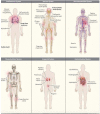Life-Threatening Infectious Complications in Sickle Cell Disease: A Concise Narrative Review
- PMID: 32154192
- PMCID: PMC7044152
- DOI: 10.3389/fped.2020.00038
Life-Threatening Infectious Complications in Sickle Cell Disease: A Concise Narrative Review
Abstract
Sickle cell disease (SCD) results in chronic hemolytic anemia, recurrent vascular occlusion, insidious vital organ deterioration, early mortality, and diminished quality of life. Life-threatening acute physiologic crises may occur on a background of progressive diminishing vital organ function. Sickle hemoglobin polymerizes in the deoxygenated state, resulting in erythrocyte membrane deformation, vascular occlusion, and hemolysis. Vascular occlusion and increased blood viscosity results in functional asplenia and immune deficiency in early childhood, resulting in life-long increased susceptibility to serious bacterial infections. Infection remains a main cause of overall mortality in patients with SCD in low- and middle-income countries due to increased exposure to pathogens, increased co-morbidities such as malnutrition, lower vaccination rates, and diminished access to definitive care, including antibiotics and blood. Thus, the greatest gains in preventing infection-associated mortality can be achieved by addressing these factors for SCD patients in austere environments. In contrast, in high-income countries, perinatal diagnosis of SCD, antimicrobial prophylaxis, vaccination, aggressive use of antibiotics for febrile episodes, and the availability of contemporary critical care resources have resulted in a significant reduction in deaths from infection; however, chronic organ injury is problematic. All clinicians, regardless of their discipline, who assume the care of SCD patients must understand the importance of infectious disease as a contributor to death and disability. In this concise narrative review, we summarize the data that describes the importance of infectious diseases as a contributor to death and disability in SCD and discuss pathophysiology, prevalent organisms, prevention, management of acute episodes of critical illness, and ongoing care.
Keywords: children; critical care; infection; prophylaxis; sepsis; sickle cell disease; vaccination.
Copyright © 2020 Ochocinski, Dalal, Black, Carr, Lew, Sullivan and Kissoon.
Figures



Similar articles
-
Infections in sickle cell disease.Haematologica. 2025 Mar 1;110(3):546-561. doi: 10.3324/haematol.2024.285066. Haematologica. 2025. PMID: 39568431 Free PMC article. Review.
-
Delayed hemolytic transfusion reaction/hyperhemolysis syndrome in children with sickle cell disease.Pediatrics. 2003 Jun;111(6 Pt 1):e661-5. doi: 10.1542/peds.111.6.e661. Pediatrics. 2003. PMID: 12777582
-
Sickle cell disease: current treatment and emerging therapies.Am J Manag Care. 2019 Nov;25(18 Suppl):S335-S343. Am J Manag Care. 2019. PMID: 31809007
-
Novel insights in the management of sickle cell disease in childhood.World J Clin Pediatr. 2016 Feb 8;5(1):25-34. doi: 10.5409/wjcp.v5.i1.25. eCollection 2016 Feb 8. World J Clin Pediatr. 2016. PMID: 26862499 Free PMC article. Review.
-
Crises in Sickle Cell Disease.Chest. 2016 Apr;149(4):1082-93. doi: 10.1016/j.chest.2015.12.016. Epub 2015 Dec 28. Chest. 2016. PMID: 26836899 Free PMC article. Review.
Cited by
-
Unrecognized hemoglobin SC sickle cell disease complicated by sepsis and cholestasis.CMAJ. 2022 May 2;194(17):E608-E611. doi: 10.1503/cmaj.210981. CMAJ. 2022. PMID: 35500915 Free PMC article. No abstract available.
-
Managing gastrointestinal challenges: Diarrhea in sickle cell anemia.Medicine (Baltimore). 2024 May 3;103(18):e38075. doi: 10.1097/MD.0000000000038075. Medicine (Baltimore). 2024. PMID: 38701274 Free PMC article. Review.
-
Caregivers' experience of seeking care for adolescents with sickle cell disease in a tertiary care hospital in Bahrain.PLoS One. 2022 Apr 7;17(4):e0266501. doi: 10.1371/journal.pone.0266501. eCollection 2022. PLoS One. 2022. PMID: 35390069 Free PMC article.
-
Prevalence, Etiological Patterns and Factors Associated with Bacteraemia Among Febrile Children with Sickle Cell Anaemia in Jinja Regional Referral Hospital, Uganda.Infect Drug Resist. 2025 Jul 7;18:3351-3368. doi: 10.2147/IDR.S527477. eCollection 2025. Infect Drug Resist. 2025. PMID: 40657276 Free PMC article.
-
Prevalence, Risk Factors, and Complications of Sickle Cell Disease in Saudi Arabia: A Systematic Review.Cureus. 2024 Jul 24;16(7):e65263. doi: 10.7759/cureus.65263. eCollection 2024 Jul. Cureus. 2024. PMID: 39184654 Free PMC article. Review.
References
Publication types
LinkOut - more resources
Full Text Sources

